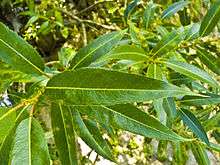Salix fragilis
| Salix fragilis | |
|---|---|
 | |
| Leaves | |
| Scientific classification | |
| Kingdom: | Plantae |
| (unranked): | Angiosperms |
| (unranked): | Eudicots |
| (unranked): | Rosids |
| Order: | Malpighiales |
| Family: | Salicaceae |
| Genus: | Salix |
| Species: | S. fragilis |
| Binomial name | |
| Salix fragilis L. | |

Salix fragilis, with the common names crack willow and brittle willow, is a species of willow native to Europe and Western Asia. It is native to riparian habitats, usually found growing beside rivers and streams, and in marshes and water meadow channels.[1][2][3]
Description
Salix fragilis is a medium-sized to large deciduous tree, which grows rapidly to 10–20 m (33–66 ft) (rarely to 29 m (95 ft)) tall, with a trunk up to 1 m (3.3 ft) diameter, often multi-trunked, and an irregular, often leaning crown. The bark is dark grey-brown, coarsely fissured in older trees. The lanceolate leaves are bright green, 9–15 cm long and 1.5–3 cm wide, with a finely serrated margin; they are very finely hairy at first in spring, but soon become hairless.[3]
The flowers are produced in catkins in early spring, and pollinated by insects. They are dioecious, with male and female catkins on separate trees; the male catkins are 4–6 cm long, the female catkins are also 4–6 cm long, with the individual flowers having either one or two nectaries.[1][2][4] In late spring fruit capsules release numerous small cotton-tufted seeds. They are easily distributed by wind and moving water, and germinate immediately after soil contact.[3]
Taxonomy
The variety Salix fragilis var. decipiens (Hoffm.) K. Koch occurs frequently with the type. It is a smaller shrubby tree, rarely exceeding 5–7 m (16–23 ft) tall, with completely hairless leaves up to 9 cm long and 2–3 cm broad. According to some botanists, it is a distinct species (treated as Salix decipiens Hoffm.), with, in this view, S. fragilis then being a hybrid between S. decipiens and S. alba. Some other botanists regard S. decipiens as itself being a hybrid between S. fragilis and S. triandra. Little evidence supports either of these suggestions.[1]
It readily forms natural hybrids with white willow S. alba in Europe and Asia, the hybrid being named Salix × rubens Schrank.[1] It can also hybridize with the native Salix nigra (black willow) in eastern North America.[3]
Ecology
The plant is commonly called crack willow or brittle willow because it is highly susceptible to wind, ice and snow damage.[3] The name also derives from the twigs which break off very easily and cleanly at the base with an audible crack. Broken twigs and branches can take root readily, enabling the species to colonise new areas as broken twigs fall into waterways and can be carried some distance downstream. It is particularly adept at colonising new riverside sandbanks formed after floods. It also spreads by root suckers, expanding into pure 'groves'.[3]
Cultivation
Salix fragilis is cultivated as a fast-growing ornamental tree. The cultivar Salix fragilis 'Russelliana' (syn. S. fragilis var. russelliana (Sm.) Koch) is by far the commonest clone of crack willow in Great Britain and Ireland, very easily propagated by cuttings. It is a vigorous tree commonly reaching 20–25 m (66–82 ft) tall, with leaves up to 15 cm long. It is a female clone.[1]
Invasive species
S. fragilis has escaped cultivation to become an invasive species in various parts of the world,[5] including: New Zealand; the upper half of the United States;[3][6] and South Africa.[7] In New Zealand it is listed on the National Pest Plant Accord, which means it cannot be sold or distributed. It can replace a habitat's native plant species diversity, by forming 'monoculture groves'. As only the male plant is present in New Zealand no fruit are formed unless hybridised.[8] Species spread is facilitated by stem Fragmentation (reproduction) which are carried via waterways. Control and management for habitat restoration projects often uses herbicides.[3]
References
- 1 2 3 4 5 Meikle, R. D. (1984). Willows and Poplars of Great Britain and Ireland. BSBI Handbook No. 4. ISBN 0-901158-07-0.
- 1 2 Rushforth, K. (1999). Trees of Britain and Europe. Collins ISBN 0-00-220013-9.
- 1 2 3 4 5 6 7 8 USFS—United States Forest Service: Salix fragilis — "Weed of the Week" . accessed 1.13.2013
- ↑ Bean, W. J. (1980). Trees and Shrubs Hardy in the British Isles 8th ed., vol. 4. John Murray ISBN 0-7195-2428-8.
- ↑ Invasive.org Salix fragilis (crack willow) . accessed 1.13.2013
- ↑ U.S. states with invasive S. fragilis sites include: CN, CO, ID, IL, IN, IO, MA, MI, MN, MO, NB, ND, NJ, OH, OR, NH, NM, NV, NY, PA, RI, SD, UT, VA, VT, WA, WI, WV, and WY. (USFS & invasive.org)
- ↑ http://www.capetowngreenmap.co.za/go-green/plant-indigenous-garden
- ↑ http://www.biosecurity.govt.nz/pests/crack-willow
External links
| Wikimedia Commons has media related to Salix fragilis. |
| Wikispecies has information related to: Salix fragilis |
- USDA Plants Profile for Salix fragilis (crack willow)
- USFS—United States Forest Service: Salix fragilis — "Weed of the Week"
- Center for Invasive Species and Ecosystem Health—Invasive.org — photos gallery.